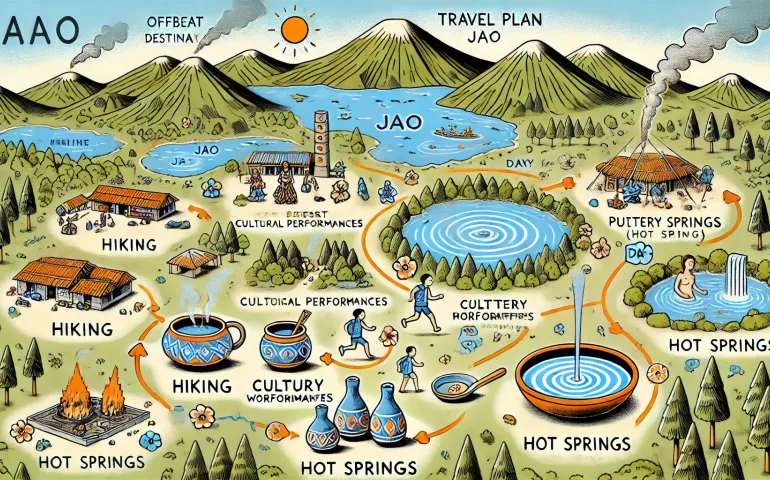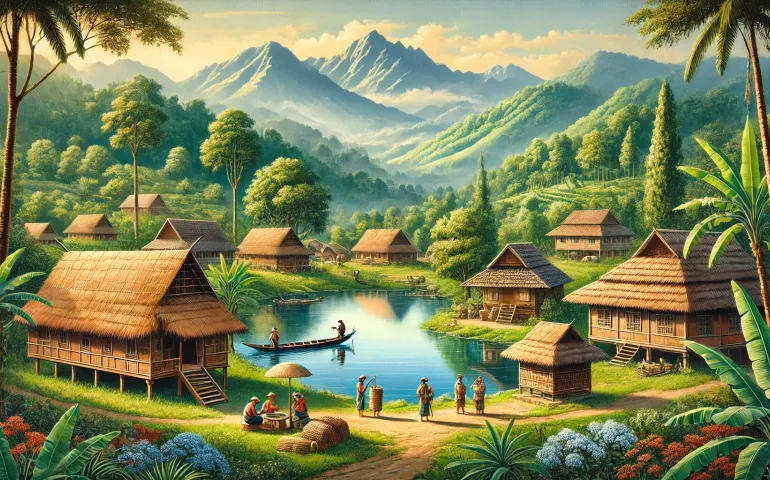About Place
- "A hidden gem nestled in lush greenery and rolling hills."
- "Untouched by mainstream tourism, Jao offers a tranquil escape."
- "A perfect blend of natural beauty and rich cultural heritage."
Reasons to Visit
- Pristine Natural Beauty : Jao is a sanctuary of untouched natural landscapes, featuring dense forests, serene lakes, and picturesque mountains. Its unspoiled environment provides a perfect retreat for nature enthusiasts and adventure seekers.
- Cultural Richness : The small community in Jao is known for its unique cultural heritage. Traditional music, dance, and crafts are integral to local life. Visitors can experience authentic cultural performances and interact with artisans who preserve age-old traditions.
- Eco-Tourism : Jao has embraced eco-friendly tourism practices, ensuring minimal impact on the environment. From eco-lodges to sustainable farming, the destination promotes responsible tourism, making it an ideal choice for environmentally conscious travelers.
Visa
- US Citizens : Visa required, obtainable upon arrival for stays up to 30 days.
- EU Citizens : Visa required, obtainable upon arrival for stays up to 30 days.
- Australian Citizens : Visa required, obtainable upon arrival for stays up to 30 days.
- Indian Citizens : Visa required, obtainable online or upon arrival for stays up to 30 days.
- Japanese Citizens : Visa required, obtainable upon arrival for stays up to 30 days.
Travel Expenses
- Travel to & from destination : Approx. $600 per person for a round-trip flight from the nearest major metro city.
- Hotel cost : Average $100 per night for 3 nights = $300 per person.
- Food cost : Average $30 per day for lunch and dinner = $90 per person.
- Activity cost : Average $50 per day for activities = $150 per person.
- Near destination travel cost : Rented vehicle for 3 days = $150.

Best Itinerary
Day 1 : Arrival and Exploration
Upon arrival in Jao, check into the eco-lodge nestled in the heart of the forest. Spend the morning exploring the nearby trails, taking in the lush scenery and spotting local wildlife. Enjoy lunch at "Green Leaf Café," offering organic farm-to-table cuisine. In the afternoon, visit the Jao Cultural Center to learn about local traditions and crafts. Dinner at "Mountain View Restaurant," known for its traditional dishes made with locally sourced ingredients. End the day stargazing from your lodge’s deck.
Day 2 : Adventure and Culture
Start your day with a guided hike to Jao's highest peak, offering panoramic views of the region. The hike begins at 8 AM and concludes by noon. For lunch, try "Lakeside Bistro," famous for its fresh fish dishes. In the afternoon, take part in a pottery workshop led by local artisans. Evening activities include a cultural dance performance at the village square. Dinner at "Heritage House," which specializes in traditional Jao cuisine. Relax in the evening with a peaceful boat ride on Jao Lake.
Day 3 : Nature and Relaxation
Begin with a morning yoga session by the lake, followed by a hearty breakfast at your lodge. Spend the late morning visiting the Butterfly Sanctuary, open from 9 AM to 12 PM. Lunch at "Forest Feast," offering vegetarian delights. The afternoon is dedicated to relaxation at the Jao Hot Springs, perfect for unwinding after days of exploration. Dinner at "Sunset Grill," where you can enjoy a barbecue with stunning sunset views. Conclude your night with a campfire under the stars, sharing stories with fellow travelers.

Safety Tips
- Always carry a map and emergency contacts.
- Stay hydrated and carry a water bottle.
- Respect local customs and traditions.
- Keep your belongings secure.
- Avoid isolated areas after dark.
- Use eco-friendly practices.
- Be cautious of wildlife.
- Have travel insurance.
- Learn basic phrases in the local language.
- Keep a first-aid kit handy.
Flights
- Airlines : Jao Air, EcoFlights, GreenSky Airlines
- Flight Duration : Approx. 4 hours from the nearest metro city.
- Cost : Around $300 one way.
Hotels
- Jao Eco-Lodge : $100/night
- Mountain Retreat : $120/night
- Forest Haven : $90/night
- Lakeview Inn : $110/night
- Village Stay : $80/night
Contacts
- Indian Embassy : +123-456-7890
- Police : 112
- Ambulance : 113
- Firefighters : 114
Country
Closet Airport
- Jao International Airport
Nearest City
- Hypothetical Metro City
Heritage Sites
Jao Cultural Center
Airlines
- Jao Air
- EcoFlights
- GreenSky Airlines
Currency
- Jao Dollar
- USD
Languages Spoken
- Jaoan
- English
Real Story
The Uprising of Jao
In the early 19th century, the region of Jao was relatively unknown to the outside world. Nestled in a remote, mountainous area, it was a sanctuary for those seeking refuge from the political turmoil of the time. This seclusion, however, would soon play a pivotal role in a significant historical event that would shape the identity of Jao for generations.
A revolutionary leader, known as Arvind, arrived in Jao seeking refuge from persecution. Arvind was a charismatic figure, known for his impassioned speeches and unwavering commitment to justice. He quickly garnered the support of the local population, who were inspired by his vision of a free and just society. Under Arvind's leadership, the people of Jao organized themselves into a cohesive resistance movement.
The turning point came when the oppressive forces attempted to invade Jao, aiming to capture Arvind and crush the burgeoning rebellion. The local population, though vastly outnumbered and outgunned, used their intimate knowledge of the terrain to their advantage. They set up strategic ambushes and employed guerrilla tactics that left the invaders disoriented and demoralized.
One of the most significant battles took place at the Valley of Echoes, a natural amphitheater surrounded by steep cliffs. Arvind and his followers used the valley's unique acoustics to amplify their war cries and create the illusion of a much larger force.
Cuisine
Jao's cuisine is a vibrant reflection of its natural abundance and cultural heritage, characterized by its simplicity, freshness, and the use of locally sourced ingredients. The culinary traditions of Jao are deeply intertwined with the land, emphasizing sustainable practices and seasonal availability. Here are some key aspects of Jaoan cuisine:
Key Ingredients
- Fish: With numerous lakes and rivers, fish is a staple in Jaoan cuisine. It is often prepared fresh, grilled, steamed, or wrapped in banana leaves for a unique, earthy flavor.
- Wild Mushrooms: The forests of Jao are home to a variety of edible mushrooms, which are foraged and used in stews, soups, and as side dishes.
- Root Vegetables: Local varieties of sweet potatoes, yams, and taro are commonly used in both savory and sweet dishes.
- Herbs and Spices: Native herbs and spices such as wild basil, lemongrass, and turmeric add depth and aroma to the dishes.
Traditional Dishes
- Banana Leaf Fish: This dish features fresh fish marinated with a blend of local herbs and spices, then wrapped in banana leaves and grilled. The banana leaves impart a subtle, smoky flavor to the fish.
- Mushroom Stew: A hearty stew made with wild mushrooms, root vegetables, and a flavorful broth seasoned with local herbs. It is often served with rice or flatbread.
- Honey-Glazed Root Vegetables: A sweet and savory dish where root vegetables are roasted and glazed with local honey, offering a caramelized finish that complements their natural sweetness.
Cooking Methods
- Grilling: A popular method, especially for fish and vegetables, which are often cooked over open flames for a smoky flavor.
- Steaming: Used to preserve the natural flavors and nutrients of ingredients, particularly for delicate items like fish and leafy greens.
- Slow Cooking: Employed for stews and soups, allowing flavors to meld together over time, resulting in rich, hearty dishes.
Signature Flavors
- Earthy and Herbal: The use of wild herbs and spices gives Jaoan dishes a distinctive earthy and herbal character.
- Sweet and Savory: Many dishes balance sweet and savory elements, often using honey, fruits, and spices.
- Fresh and Light: The emphasis on fresh, locally sourced ingredients ensures that the cuisine is light and wholesome.
Unique Culinary Experiences
- Farm-to-Table Dining: Many restaurants in Jao follow the farm-to-table concept, offering meals prepared with ingredients sourced directly from local farms and gardens.
- Foraging Tours: Visitors can join guided foraging tours to collect wild mushrooms, herbs, and other edible plants, which are then used in a cooking class or prepared by local chefs.
- Traditional Cooking Classes: These classes provide hands-on experience in preparing traditional Jaoan dishes, offering insight into the techniques and ingredients that define the local cuisine.

Culture and History
Jao's culture is an intricate tapestry woven from its natural surroundings, historical experiences, and the traditions of its people. The residents of Jao have long maintained a deep connection to the environment, a relationship reflected in their daily lives and cultural practices.
Connection to Nature
Nature plays a pivotal role in Jao’s cultural identity. The community's customs and celebrations are often tied to the natural calendar, with festivals marking the changing seasons, harvests, and lunar cycles. The annual Harvest Festival is a major event, where locals give thanks for the bounty of the land with feasting, music, and dance. Traditional dances often mimic the movements of local wildlife and the rhythms of natural phenomena like rainfall and wind.
Traditional Crafts and Artistry
Jao is renowned for its artisanal crafts, particularly pottery, weaving, and wood carving. These crafts are not only a means of artistic expression but also hold significant cultural and historical importance. Pottery, for example, often features intricate designs that tell stories of the land and its people. Weaving practices use natural dyes and fibers to create textiles that are both functional and beautiful, often used in ceremonial attire and everyday life.
Music and Dance
Music in Jao is characterized by the use of traditional instruments such as bamboo flutes, hand drums, and stringed instruments made from local materials. Songs often recount historical events, legends, and the beauty of the natural world. Dance is a vital part of Jao's cultural expression, with performances often held in communal spaces like village squares or near significant natural landmarks. These dances serve both as entertainment and as a means of preserving historical narratives and social values.
Historical Influences
Historically, Jao has been a place of refuge and resistance. Its remote location provided sanctuary for those fleeing persecution, and it became a center of revolutionary activity in the 19th century. This history of defiance and resilience is a source of great pride for the people of Jao and is commemorated in various cultural events, such as the Freedom Festival, which celebrates the region's struggle for independence.
Daily Life and Social Structure
The social structure in Jao is largely communal, with an emphasis on cooperation and mutual support. Villages are typically governed by councils of elders who make decisions based on consensus and the well-being of the community. This collective approach extends to agriculture, where communal farming practices are common, and to social services, such as education and healthcare, which are organized at the community level.
